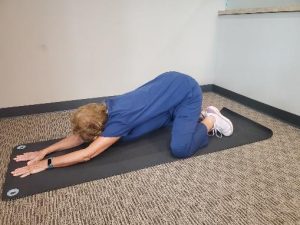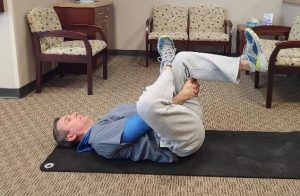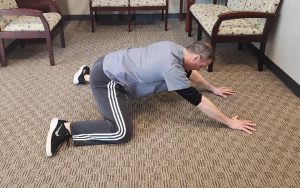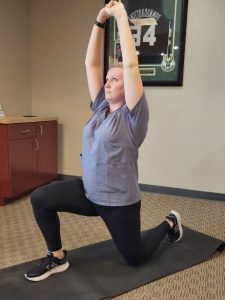Tight Hips Can Contribute to Back Pain
 More often than not, when we develop back pain, we instantly assume that the problem
More often than not, when we develop back pain, we instantly assume that the problem
is coming from our back since that is what hurts. The reality is that while there may be a
problem in that lower back, the root cause is often due to something else, and the pain is
manifesting itself there. The lower back should be a very stable area in our body. The joints
above and below, the thoracic spine and the hips, should be mobile. But what happens when
those joints aren’t mobile, what happens when our hips tighten up due to sitting too much at
work or our mid back (thoracic spine) tightens up due to poor posture? Ultimately, our lower
back starts hurting because a lot of those hip and thoracic spine muscles attach in the lower
back. So, as they tighten up, they will pull in the lower back, potentially changing how you move
causing back pain or even worse, pulling the lumbar spine to cause your intervertebral discs to
herniate. Keeping our hips and thoracic spine mobile is one of the keys to a healthy lower back.
Here are eight stretches to help keep those joints mobile and your body moving freely.
Cat/Cow Stretch (for hips, low back, thoracic spine, shoulders)
- You are doing this to mobilize the hips and spine.
- Start on your hands and knees with your hands under your shoulders and knees under your hips.
- As you sink your belly towards the floor, look up while you breathe in.
- As you exhale, round your back towards the ceiling, tucking your chin and looking down and back between your legs.
- Breathe slowly and perform the movement with each breath.


Child’s Pose (for inner thigh, low back, shoulders)
- Start on your hands and knees.
- Keep your big toes together and move your knees out towards the sides of the mat to open up your hips.
- As you sit your hips back on your heels, slide your arms out in front of you, slowly lowering your chest towards your knees/floor.
- Hold this stretch for 5 slow deep breaths, breathing in through your nose, filling your belly and back with air, holding the breath for 5 seconds and then exhaling slowly through your mouth.

Thoracic Rotational Reach Through (for shoulders, thoracic spine)
- Start on your hands and knees, with your hands under your shoulders and knees under your hips.
- Take one hand and reach under and across to the opposite side.
- Breathe in and as you exhale, bring the arm back and then reach up towards the ceiling.
- Focus on keeping your hips stable.


Supine Piriformis Stretch (for piriformis, glutes, low back)
- Lying on the floor on your back, bend your knees, and keep your feet flat on the floor.
- Cross one ankle over the other knee, allowing that knee to fall open.
- For a deeper stretch, reach between your legs and grab the back of your bent leg.
- Pull the knee towards your chest as you lie your head and shoulders back down on the floor.
- Hold this stretch for 5 slow, deep breaths, breathing in through your nose, filling your belly and back with air, hold the inhale for a few seconds and then exhale through your mouth.

Deep Lunge with Thoracic Rotational Reach (for shoulders, thoracic spine, groin, hip flexor, quadriceps)
- Start in push-up position.
- Step your right foot forward, stepping outside your right hand.
- Keeping the core engaged, slowly lower into your hips, while keeping the back leg straight.
- For a deeper stretch, bring your right elbow down towards the floor to the instep of your foot.
- Hold this position for 1-2 slow breaths.
- Then slowly lift your right hand and rotate your torso, reaching up towards the ceiling.
- Bring the hand back down to the floor inside the foot.
- Brace your midsection and slowly step back into push-up position.


Frog Stretch (for shoulders, low back, groin, inner thigh)
- Start on your hands and knees with your hands under your shoulders and knees under your hips.
- Spread your knees as wide as you can and then bring your ankles in-line with your knees, turning your feet out.
- Maintaining a tall, neutral spine, slowly sit your hips back towards your heels to stretch your inner thighs and groin.
- Hold the stretch for a 3-5 slow, deep breaths, and then shift your weight forward to release the stretch.

Half-kneeling Hip Flexor Stretch (for hip flexors, quadriceps, psoas)
- Start by kneeling down on one knee.
- Make sure that your down knee is under your hip and that your front knee is over your ankle.
- When performing this stretch, it is important to contract the glute of the down knee to stabilize the hips.
- Gently slide the body forward while keeping the glute engaged.
- Then reach straight up to the ceiling, actively reaching through the finger tips.
- Hold this stretch for 3-5 slow, deep breaths and then relax.

Downward Dog Pose (for shoulders, low back, and hamstrings)
- Start in a High Plank/Push-Up position.
- Slowly drive your hips up to the corner of the ceiling, lowering your chest towards your thighs and pressing your heels to the floor.
- It is important that you keep your neck neutral and to think about pressing the floor away from you to lengthen through your shoulder joint.
- Hold the pose for 3-5 slow, deep breaths before returning to the High Plank position.

For best results, hold each of these stretches for 3-5 slow deep breaths, inhaling for 4 seconds, holding your breath for 4 seconds, and exhaling for 4-8 seconds. For the movement stretches of Cat/Cow and Thoracic Rotational Reach Through, perform 6-10 repetitions of each. For single sided stretches, remember to perform the stretch on the other side. Remember, one of the main keys to helping a healthy lower back is to keep the hips and thoracic spine limber and mobile.

